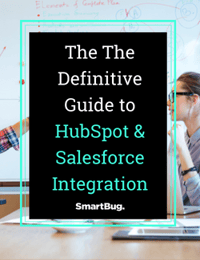
Choosing the right customer relationship management (CRM) platform is essential for making confident, data-driven decisions about your sales and marketing. If your company is juggling both HubSpot and Salesforce, or you’re debating whether to go all in on one, it can be tough to know which move is best for your growth.
In a recent episode of SmartBug on Tap, Casey Peddicord and Alex Bisaillon from SmartBug Media discussed how to navigate HubSpot and Salesforce integration, when integrating makes sense, when a full migration is the smarter path, and how to avoid common pitfalls that can slow you down.
Table of Contents
- When is integration the right approach?
- What makes a HubSpot and Salesforce integration successful?
- How can you tell when your integration isn’t going as intended?
- How do you tell if HubSpot or Salesforce should be your source of truth?
- When does it make sense to do a full migration?
- How can you avoid common traps that can slow down your growth?
When is integration the right approach?
Alex kicked off our discussion by explaining that integration is often the best path when marketing attribution and full-funnel visibility are priorities. If your marketing team is working in HubSpot and your sales team is in Salesforce, syncing the two allows you to finally connect the dots and see which campaigns are actually driving revenue.
When both systems are talking to each other, you gain a clear view of handoffs, sales outcomes, and campaign performance, making it possible to report on dollars spent versus dollars earned.
It’s also the right move when you want more flexible reporting options. For example, you may prefer to build sales reports in HubSpot, even if Salesforce remains the system of record for deals. Integration gives you the flexibility you desire, letting HubSpot handle pipeline activity while Salesforce continues to own the sales process in the background.
The results? Less manual work, better visibility, and smarter decisions across teams.
Key takeaway: Integrating HubSpot and Salesforce isn’t just about syncing your data. It’s about giving your marketing and sales teams a shared view of what’s working so you can tie every campaign to real revenue.
What makes a HubSpot and Salesforce integration successful?
Alex emphasized that the human side can’t be forgotten in a HubSpot and Salesforce integration. The success of your integration is as dependent on human collaboration as it is on setting it up.
This means creating space for real conversations between marketing and sales teams. How does a lead get passed? What feedback loops need to exist? What counts as a qualified lead, and who decides?
Alex added that, for him, it’s all about a good mapping session and truly understanding what’s important for the client. No two integrations are alike, so it’s essential to have experts who understand the systems, how marketing and sales think, and what’s beneficial for the client.
Key takeaway: A successful HubSpot-Salesforce integration isn’t just about syncing data. It’s about making sure you have that human touch and collaboration.
How can you tell when your integration isn’t going as intended?
Sometimes, the clearest sign that your integration isn’t working is when you can’t answer basic questions, such as “How many leads from our last campaign are close to converting?” or “What’s our sales team actually doing with the leads we’re sending?” If you’re coming up empty with answers to those questions, something is likely off.
Key takeaway: If you can’t answer questions about your marketing and sales performance, your integration likely needs attention. The right setup should bring clarity—not confusion.
How do you tell if HubSpot or Salesforce should be your source of truth?
If marketing owns the early part of the customer journey, such as generating and nurturing leads, you might lean toward HubSpot as your primary system. If the sales team owns the process once leads are qualified, Salesforce may take over from there. With a good integration, you can set up a clean handoff while maintaining full visibility across both platforms.
Additionally, if reporting and visibility matter most inside HubSpot, HubSpot must hold the final version of your customer data. The system where you need the clearest reporting should be the system of record.
Key takeaway: Choose your source of truth based on where clean, actionable data that’s easy to report on matters most to your team.
When does it make sense to do a full migration?
Are you working for your CRM, or is your CRM working for you? One of the most important things to understand is when it’s time to move out of Salesforce and fully into HubSpot.
Here are some of the signs Alex said to be aware of and questions to ask yourself:
- If you’re spending more time managing tasks than selling, you’re losing productivity and revenue, and you could be working for your CRM instead of the other way around.
- How easy is your current solution to operate?
- How easy is it for you to find your data?
Key takeaway: Your CRM should make life easier—not harder. If you’re spending more time managing tasks and updating records, it’s time to rethink your CRM.
How can you avoid common traps that can slow down your growth?
After hundreds of Salesforce migrations and integrations over the years, we’ve seen what works—and what doesn’t. Here are the most important lessons Alex has learned:
- Take your time, and don’t rush. Allow at least three months to fully plan, migrate, and adapt to the new system.
- Plan for change and team adoption. Allow time and space for your teams to feel comfortable being uncomfortable with a new system.
- Capture user stories. User stories from your team can help guide your migration setup, allow for better testing, and ensure your system matches what your team needs.
- Talk to the partner who is doing your integration work. Make sure you can talk to the partner who is actually doing your integration work. Ask if the work is being outsourced or not. The partner will be handling a lot of sensitive data that you don’t want to be vulnerable, and communication could also be complicated. They should show you examples of past experiences and walk you through the process. It’s also important to know how they’ll handle and communicate challenges that arise.
Pro tip: At SmartBug, we do all of our work in-house and don’t outsource.
Final thoughts: Let SmartBug help.
The right CRM should make your teams faster and more connected—not stuck managing tasks or chasing down data. If you’re ready for a CRM that actually drives your business forward, let’s talk. SmartBug’s experts are here to help you find the clearest, most confident path for your sales and marketing teams.

About the author
Nicole Horning Nicole Horning has been a copywriter at SmartBug since 2022. She has nearly 10 years of experience writing and editing for publishing companies, health insurance, and marketing agencies. Nicole has a deep love for reading and learning as well as a passion for healthcare and senior living writing. Read more articles by Nicole Horning.







-2.png?width=800&length=800&name=Blog%20header%20image%20(1)-2.png)